Report on Wind Speed Analysis: Numeracy, Data & Forecasting Model
VerifiedAdded on 2023/06/11
|9
|1531
|200
Report
AI Summary
This report provides a comprehensive analysis of wind speed data for a specific country, employing numeracy and data analysis techniques to extract valuable insights for future decision-making. It covers calculations such as mean, median, mode, standard deviation, and range to understand th...
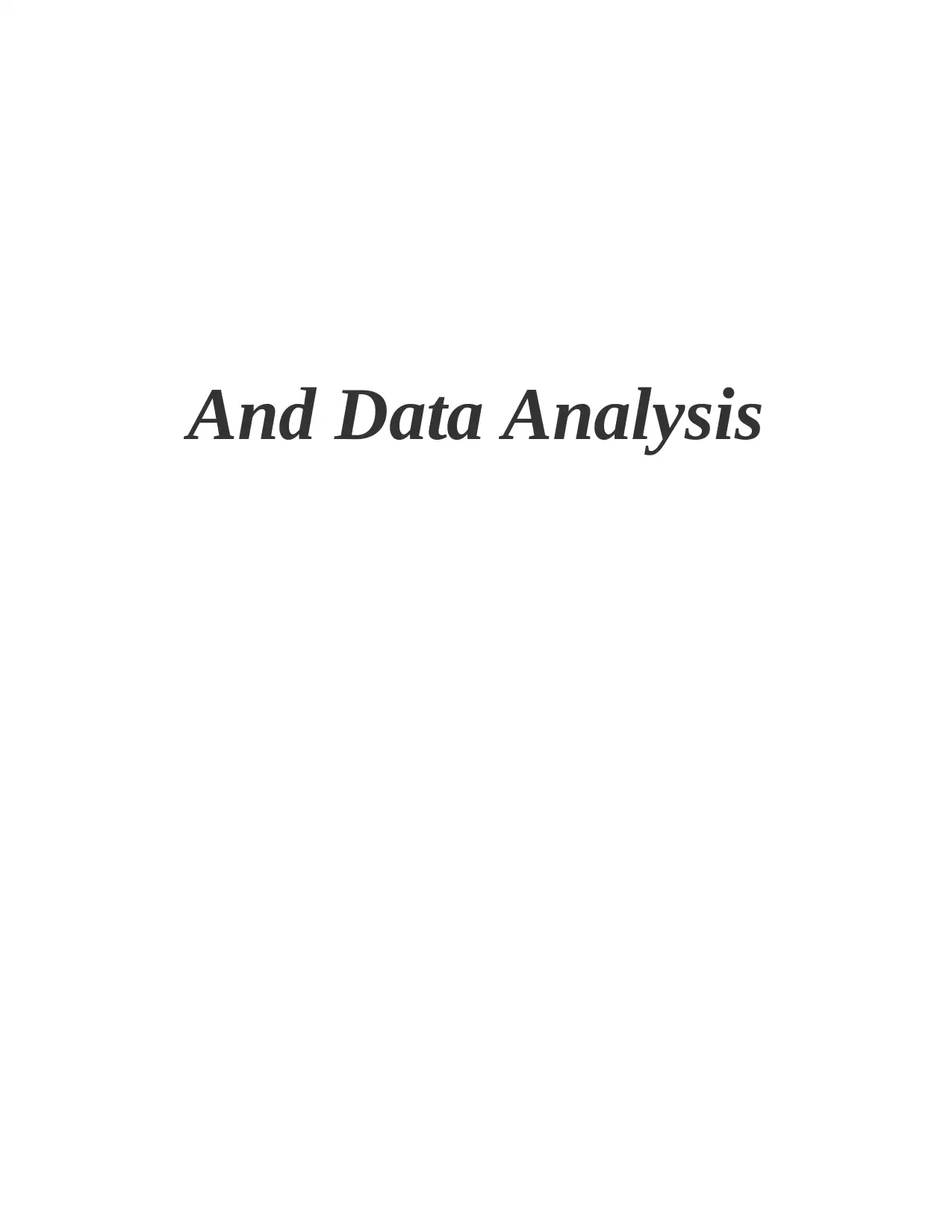
And Data Analysis
Paraphrase This Document
Need a fresh take? Get an instant paraphrase of this document with our AI Paraphraser
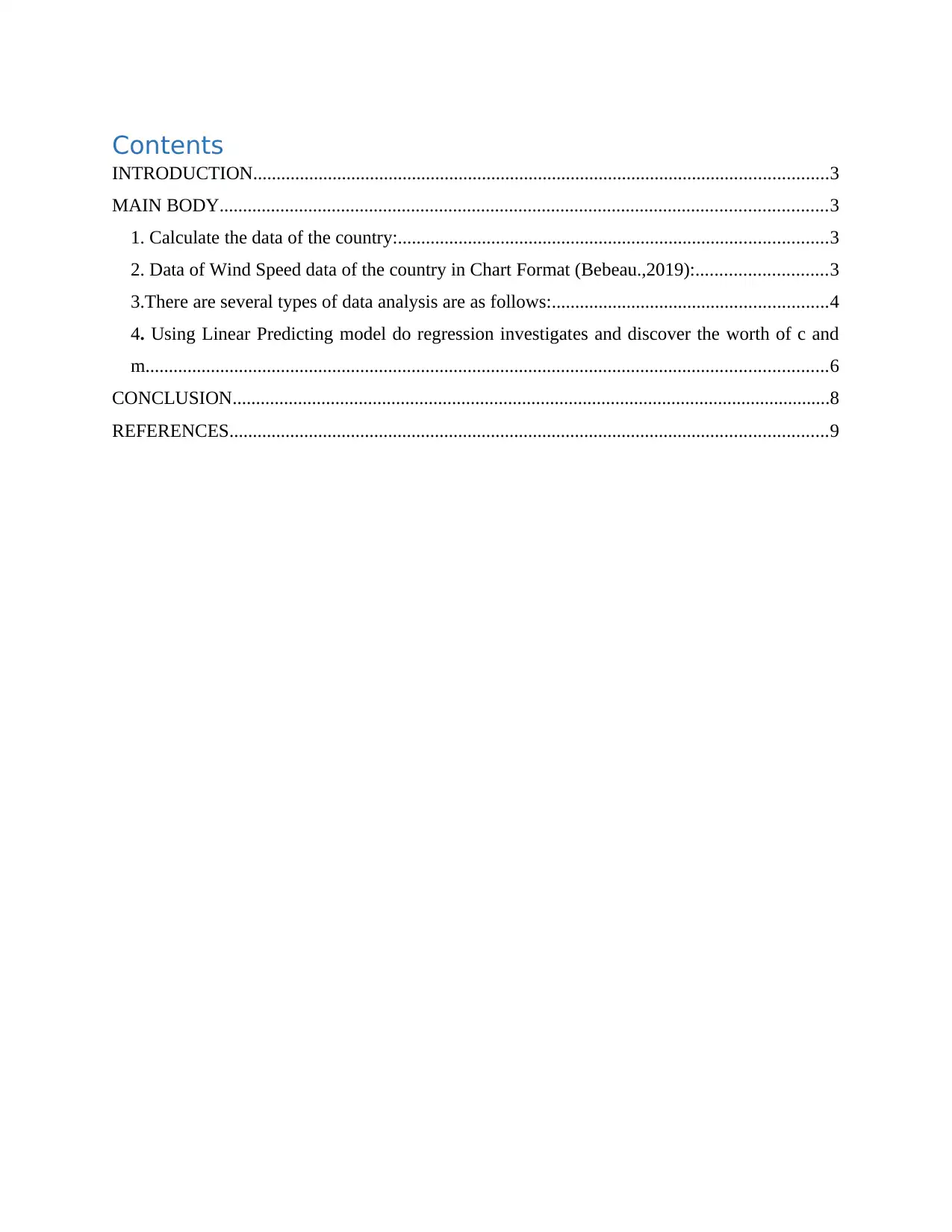
Contents
INTRODUCTION...........................................................................................................................3
MAIN BODY..................................................................................................................................3
1. Calculate the data of the country:............................................................................................3
2. Data of Wind Speed data of the country in Chart Format (Bebeau.,2019):............................3
3.There are several types of data analysis are as follows:...........................................................4
4. Using Linear Predicting model do regression investigates and discover the worth of c and
m..................................................................................................................................................6
CONCLUSION................................................................................................................................8
REFERENCES................................................................................................................................9
INTRODUCTION...........................................................................................................................3
MAIN BODY..................................................................................................................................3
1. Calculate the data of the country:............................................................................................3
2. Data of Wind Speed data of the country in Chart Format (Bebeau.,2019):............................3
3.There are several types of data analysis are as follows:...........................................................4
4. Using Linear Predicting model do regression investigates and discover the worth of c and
m..................................................................................................................................................6
CONCLUSION................................................................................................................................8
REFERENCES................................................................................................................................9
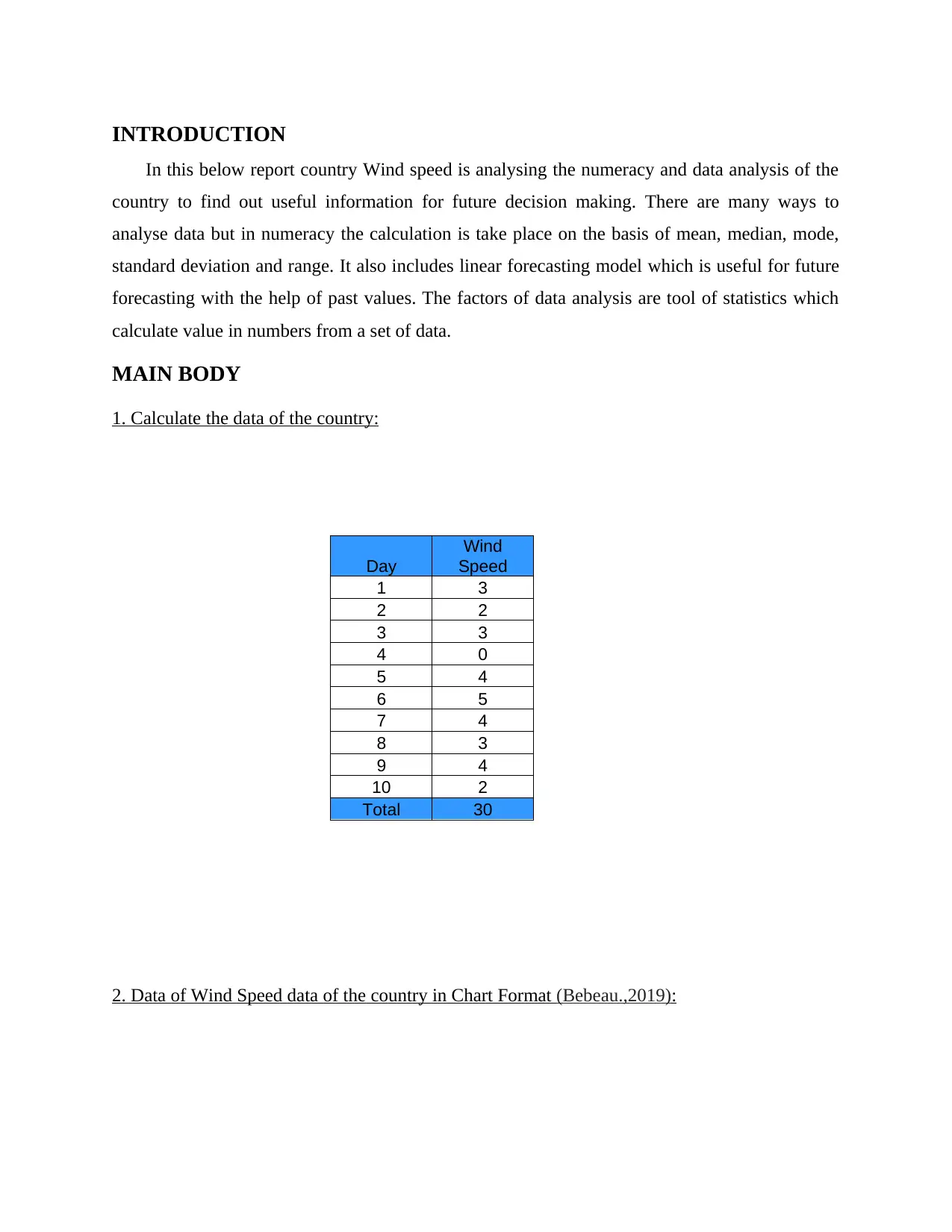
INTRODUCTION
In this below report country Wind speed is analysing the numeracy and data analysis of the
country to find out useful information for future decision making. There are many ways to
analyse data but in numeracy the calculation is take place on the basis of mean, median, mode,
standard deviation and range. It also includes linear forecasting model which is useful for future
forecasting with the help of past values. The factors of data analysis are tool of statistics which
calculate value in numbers from a set of data.
MAIN BODY
1. Calculate the data of the country:
Day
Wind
Speed
1 3
2 2
3 3
4 0
5 4
6 5
7 4
8 3
9 4
10 2
Total 30
2. Data of Wind Speed data of the country in Chart Format (Bebeau.,2019):
In this below report country Wind speed is analysing the numeracy and data analysis of the
country to find out useful information for future decision making. There are many ways to
analyse data but in numeracy the calculation is take place on the basis of mean, median, mode,
standard deviation and range. It also includes linear forecasting model which is useful for future
forecasting with the help of past values. The factors of data analysis are tool of statistics which
calculate value in numbers from a set of data.
MAIN BODY
1. Calculate the data of the country:
Day
Wind
Speed
1 3
2 2
3 3
4 0
5 4
6 5
7 4
8 3
9 4
10 2
Total 30
2. Data of Wind Speed data of the country in Chart Format (Bebeau.,2019):
⊘ This is a preview!⊘
Do you want full access?
Subscribe today to unlock all pages.

Trusted by 1+ million students worldwide

Chart: Chart shows different temperature of the previous 10 days.
3.There are several types of data analysis are as follows:
Mean: Mean is the value which is useful for analysing the average value from a given set
of data. The mean is calculated by dividing the sum of all the data given with number of data
given.
Following steps to be taken for calculating mean (Bennison.,2020):
Step 1: Collect the given data.
Step 2: Calculate the sum of data.
Step 3: Calculate the total number of data.
Step 4: Divide the sum of data with total number of data.
Mean of Wind Speed = Sum of data set / Total number of data set
Mean = 30 / 10
3.There are several types of data analysis are as follows:
Mean: Mean is the value which is useful for analysing the average value from a given set
of data. The mean is calculated by dividing the sum of all the data given with number of data
given.
Following steps to be taken for calculating mean (Bennison.,2020):
Step 1: Collect the given data.
Step 2: Calculate the sum of data.
Step 3: Calculate the total number of data.
Step 4: Divide the sum of data with total number of data.
Mean of Wind Speed = Sum of data set / Total number of data set
Mean = 30 / 10
Paraphrase This Document
Need a fresh take? Get an instant paraphrase of this document with our AI Paraphraser
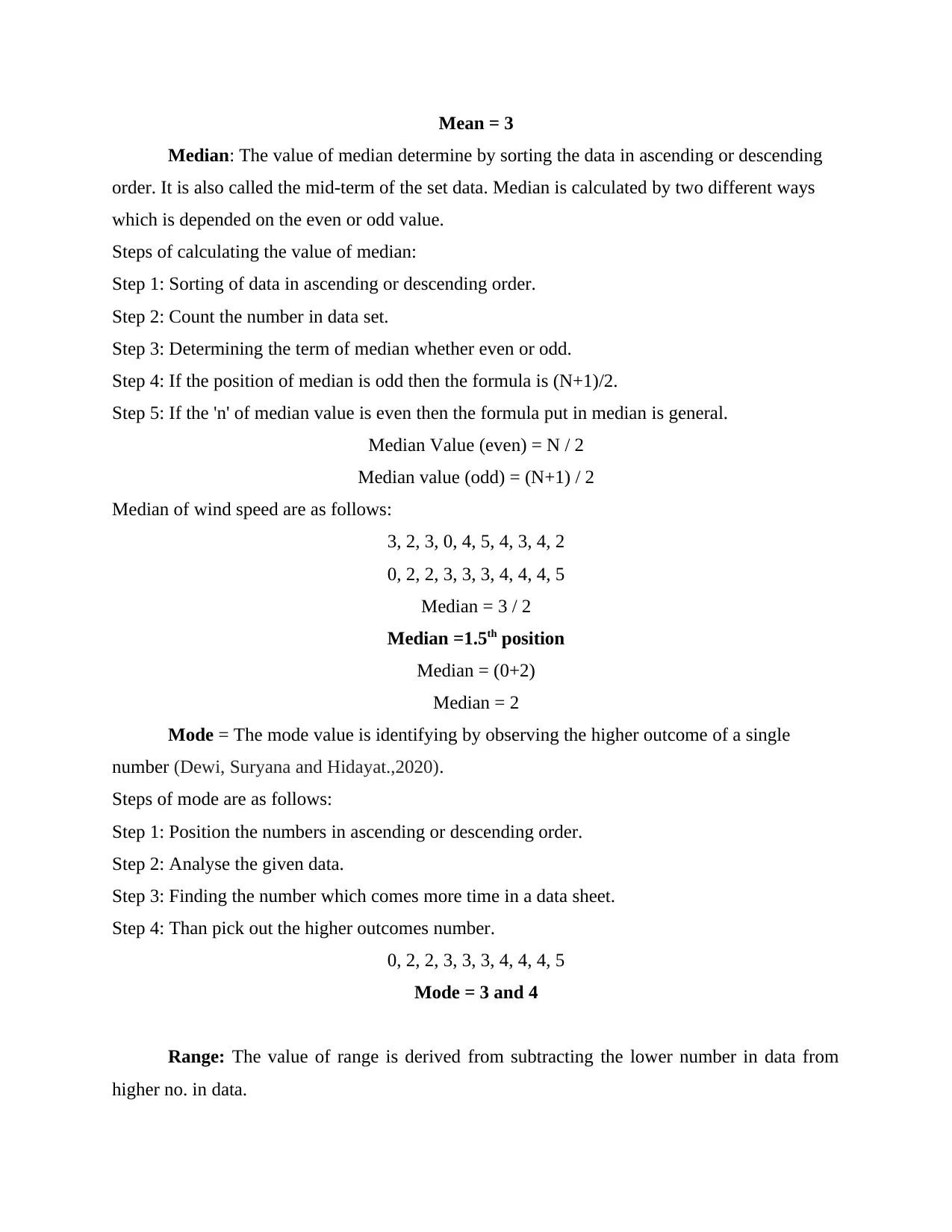
Mean = 3
Median: The value of median determine by sorting the data in ascending or descending
order. It is also called the mid-term of the set data. Median is calculated by two different ways
which is depended on the even or odd value.
Steps of calculating the value of median:
Step 1: Sorting of data in ascending or descending order.
Step 2: Count the number in data set.
Step 3: Determining the term of median whether even or odd.
Step 4: If the position of median is odd then the formula is (N+1)/2.
Step 5: If the 'n' of median value is even then the formula put in median is general.
Median Value (even) = N / 2
Median value (odd) = (N+1) / 2
Median of wind speed are as follows:
3, 2, 3, 0, 4, 5, 4, 3, 4, 2
0, 2, 2, 3, 3, 3, 4, 4, 4, 5
Median = 3 / 2
Median =1.5th position
Median = (0+2)
Median = 2
Mode = The mode value is identifying by observing the higher outcome of a single
number (Dewi, Suryana and Hidayat.,2020).
Steps of mode are as follows:
Step 1: Position the numbers in ascending or descending order.
Step 2: Analyse the given data.
Step 3: Finding the number which comes more time in a data sheet.
Step 4: Than pick out the higher outcomes number.
0, 2, 2, 3, 3, 3, 4, 4, 4, 5
Mode = 3 and 4
Range: The value of range is derived from subtracting the lower number in data from
higher no. in data.
Median: The value of median determine by sorting the data in ascending or descending
order. It is also called the mid-term of the set data. Median is calculated by two different ways
which is depended on the even or odd value.
Steps of calculating the value of median:
Step 1: Sorting of data in ascending or descending order.
Step 2: Count the number in data set.
Step 3: Determining the term of median whether even or odd.
Step 4: If the position of median is odd then the formula is (N+1)/2.
Step 5: If the 'n' of median value is even then the formula put in median is general.
Median Value (even) = N / 2
Median value (odd) = (N+1) / 2
Median of wind speed are as follows:
3, 2, 3, 0, 4, 5, 4, 3, 4, 2
0, 2, 2, 3, 3, 3, 4, 4, 4, 5
Median = 3 / 2
Median =1.5th position
Median = (0+2)
Median = 2
Mode = The mode value is identifying by observing the higher outcome of a single
number (Dewi, Suryana and Hidayat.,2020).
Steps of mode are as follows:
Step 1: Position the numbers in ascending or descending order.
Step 2: Analyse the given data.
Step 3: Finding the number which comes more time in a data sheet.
Step 4: Than pick out the higher outcomes number.
0, 2, 2, 3, 3, 3, 4, 4, 4, 5
Mode = 3 and 4
Range: The value of range is derived from subtracting the lower number in data from
higher no. in data.

Steps to calculate the Range Value:
Step 1: Sort the data in a proper way.
Step 2: Pick out the highest and lowest value.
Step 3: Calculate the difference between maximum and minimum.
Step 4: At the end, the value of range is calculated.
Calculation of wind speed range:
Range = Highest value – Lowest Value
=5 – 0
Range = 5
Standard Deviation: The value of standard deviation is calculating the number of spread
data in relation to the value of mean.
Steps to calculate the standard deviation (Díez-Palomar.,2020):
Step1: First, find the value of mean.
Step2: To calculate each and every given value deviation form mean.
Step3: Then Calculate the sum of squares.
Step4: After that divided by the total number of data.
Step5: At last, take square of the above calculated value.
Standard Deviation= √∑ (xi – μ) 2 / N
=√18 / 10
Standard Deviation = 1.34
4. Using Linear Predicting model do regression investigates and discover the worth of c and m.
Linear forecasting Theory: This theory is prepared on the basis of past calculation report.
It is helpful for future forecasting.
Following are the steps of Linear forecasting theory;
Step1: Find out the problem.
Step2: Search and collect the information.
Step3: Observe the analysis from beginning.
Step4: Pick out the model for future practices.
Step5: Check all the data and performance of model.
y = mx + C
where, 'y' is referring to Dependent Factor,
Step 1: Sort the data in a proper way.
Step 2: Pick out the highest and lowest value.
Step 3: Calculate the difference between maximum and minimum.
Step 4: At the end, the value of range is calculated.
Calculation of wind speed range:
Range = Highest value – Lowest Value
=5 – 0
Range = 5
Standard Deviation: The value of standard deviation is calculating the number of spread
data in relation to the value of mean.
Steps to calculate the standard deviation (Díez-Palomar.,2020):
Step1: First, find the value of mean.
Step2: To calculate each and every given value deviation form mean.
Step3: Then Calculate the sum of squares.
Step4: After that divided by the total number of data.
Step5: At last, take square of the above calculated value.
Standard Deviation= √∑ (xi – μ) 2 / N
=√18 / 10
Standard Deviation = 1.34
4. Using Linear Predicting model do regression investigates and discover the worth of c and m.
Linear forecasting Theory: This theory is prepared on the basis of past calculation report.
It is helpful for future forecasting.
Following are the steps of Linear forecasting theory;
Step1: Find out the problem.
Step2: Search and collect the information.
Step3: Observe the analysis from beginning.
Step4: Pick out the model for future practices.
Step5: Check all the data and performance of model.
y = mx + C
where, 'y' is referring to Dependent Factor,
⊘ This is a preview!⊘
Do you want full access?
Subscribe today to unlock all pages.

Trusted by 1+ million students worldwide
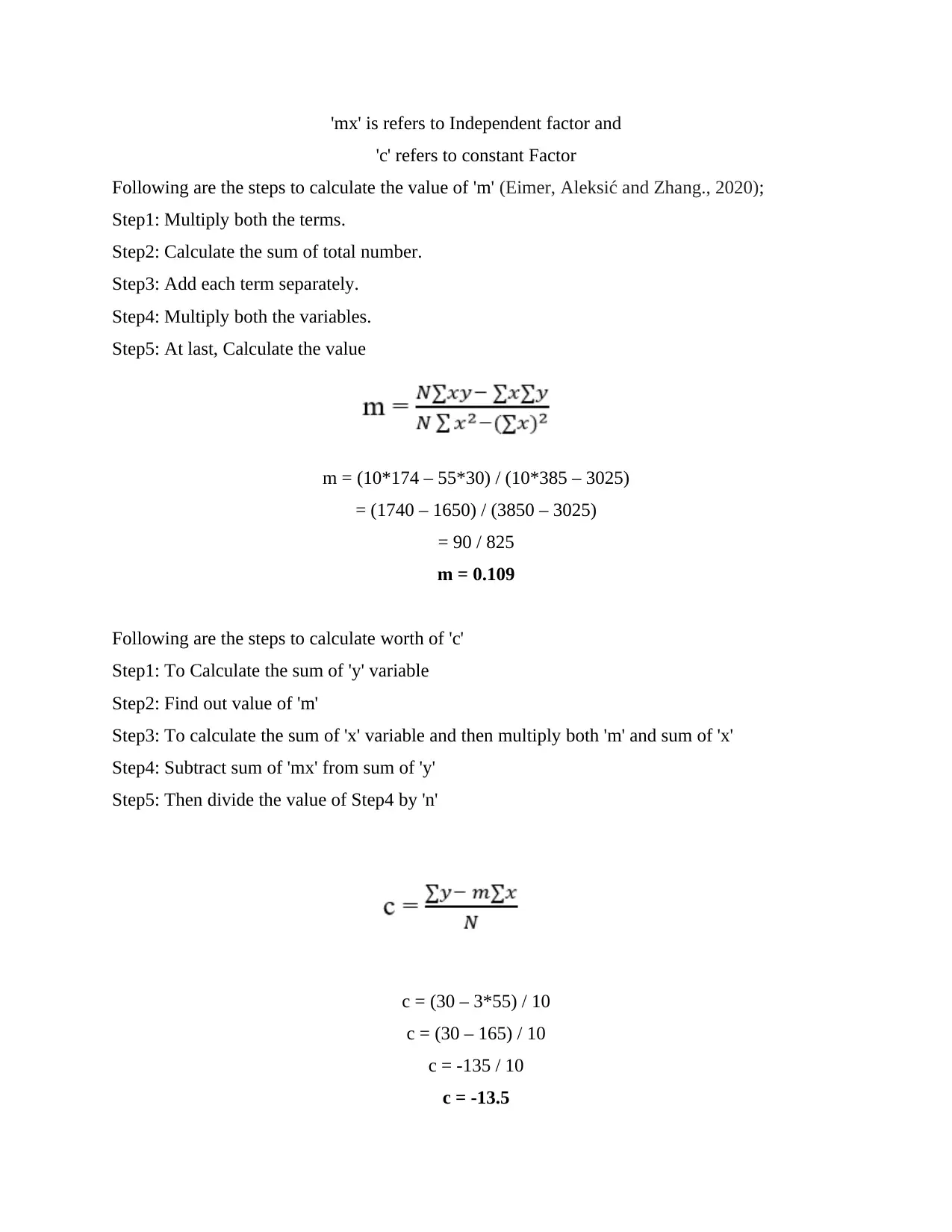
'mx' is refers to Independent factor and
'c' refers to constant Factor
Following are the steps to calculate the value of 'm' (Eimer, Aleksić and Zhang., 2020);
Step1: Multiply both the terms.
Step2: Calculate the sum of total number.
Step3: Add each term separately.
Step4: Multiply both the variables.
Step5: At last, Calculate the value
m = (10*174 – 55*30) / (10*385 – 3025)
= (1740 – 1650) / (3850 – 3025)
= 90 / 825
m = 0.109
Following are the steps to calculate worth of 'c'
Step1: To Calculate the sum of 'y' variable
Step2: Find out value of 'm'
Step3: To calculate the sum of 'x' variable and then multiply both 'm' and sum of 'x'
Step4: Subtract sum of 'mx' from sum of 'y'
Step5: Then divide the value of Step4 by 'n'
c = (30 – 3*55) / 10
c = (30 – 165) / 10
c = -135 / 10
c = -13.5
'c' refers to constant Factor
Following are the steps to calculate the value of 'm' (Eimer, Aleksić and Zhang., 2020);
Step1: Multiply both the terms.
Step2: Calculate the sum of total number.
Step3: Add each term separately.
Step4: Multiply both the variables.
Step5: At last, Calculate the value
m = (10*174 – 55*30) / (10*385 – 3025)
= (1740 – 1650) / (3850 – 3025)
= 90 / 825
m = 0.109
Following are the steps to calculate worth of 'c'
Step1: To Calculate the sum of 'y' variable
Step2: Find out value of 'm'
Step3: To calculate the sum of 'x' variable and then multiply both 'm' and sum of 'x'
Step4: Subtract sum of 'mx' from sum of 'y'
Step5: Then divide the value of Step4 by 'n'
c = (30 – 3*55) / 10
c = (30 – 165) / 10
c = -135 / 10
c = -13.5
Paraphrase This Document
Need a fresh take? Get an instant paraphrase of this document with our AI Paraphraser
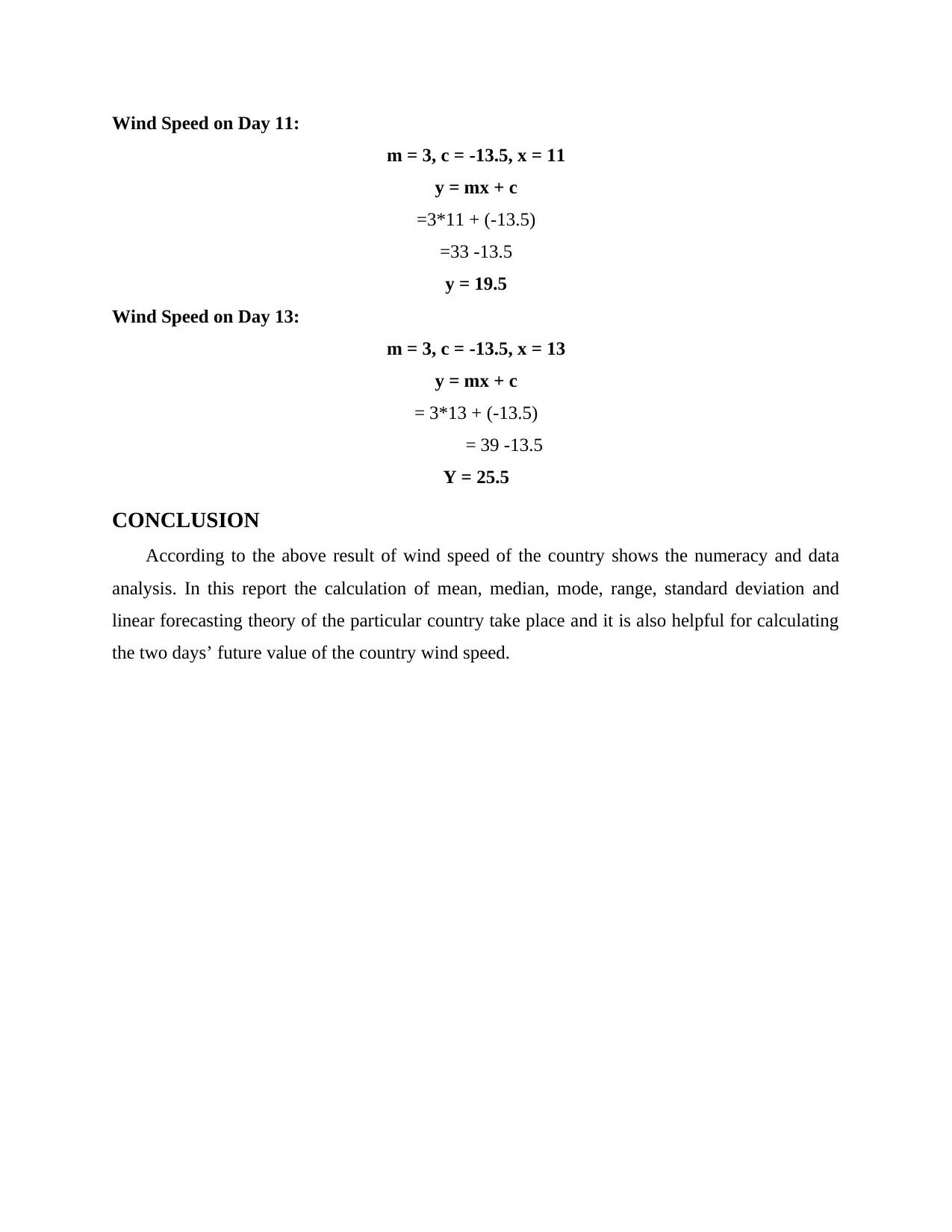
Wind Speed on Day 11:
m = 3, c = -13.5, x = 11
y = mx + c
=3*11 + (-13.5)
=33 -13.5
y = 19.5
Wind Speed on Day 13:
m = 3, c = -13.5, x = 13
y = mx + c
= 3*13 + (-13.5)
= 39 -13.5
Y = 25.5
CONCLUSION
According to the above result of wind speed of the country shows the numeracy and data
analysis. In this report the calculation of mean, median, mode, range, standard deviation and
linear forecasting theory of the particular country take place and it is also helpful for calculating
the two days’ future value of the country wind speed.
m = 3, c = -13.5, x = 11
y = mx + c
=3*11 + (-13.5)
=33 -13.5
y = 19.5
Wind Speed on Day 13:
m = 3, c = -13.5, x = 13
y = mx + c
= 3*13 + (-13.5)
= 39 -13.5
Y = 25.5
CONCLUSION
According to the above result of wind speed of the country shows the numeracy and data
analysis. In this report the calculation of mean, median, mode, range, standard deviation and
linear forecasting theory of the particular country take place and it is also helpful for calculating
the two days’ future value of the country wind speed.
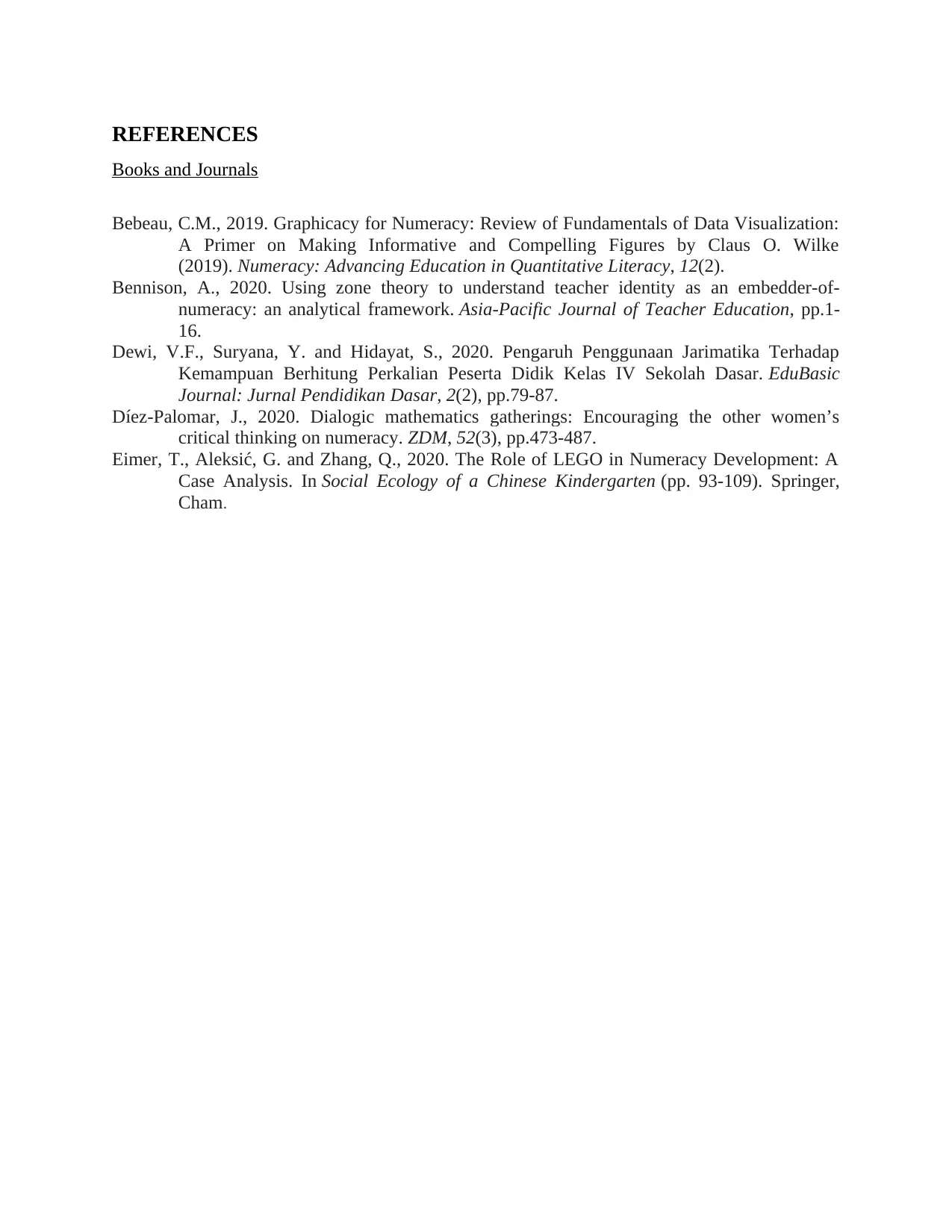
REFERENCES
Books and Journals
Bebeau, C.M., 2019. Graphicacy for Numeracy: Review of Fundamentals of Data Visualization:
A Primer on Making Informative and Compelling Figures by Claus O. Wilke
(2019). Numeracy: Advancing Education in Quantitative Literacy, 12(2).
Bennison, A., 2020. Using zone theory to understand teacher identity as an embedder-of-
numeracy: an analytical framework. Asia-Pacific Journal of Teacher Education, pp.1-
16.
Dewi, V.F., Suryana, Y. and Hidayat, S., 2020. Pengaruh Penggunaan Jarimatika Terhadap
Kemampuan Berhitung Perkalian Peserta Didik Kelas IV Sekolah Dasar. EduBasic
Journal: Jurnal Pendidikan Dasar, 2(2), pp.79-87.
Díez-Palomar, J., 2020. Dialogic mathematics gatherings: Encouraging the other women’s
critical thinking on numeracy. ZDM, 52(3), pp.473-487.
Eimer, T., Aleksić, G. and Zhang, Q., 2020. The Role of LEGO in Numeracy Development: A
Case Analysis. In Social Ecology of a Chinese Kindergarten (pp. 93-109). Springer,
Cham.
Books and Journals
Bebeau, C.M., 2019. Graphicacy for Numeracy: Review of Fundamentals of Data Visualization:
A Primer on Making Informative and Compelling Figures by Claus O. Wilke
(2019). Numeracy: Advancing Education in Quantitative Literacy, 12(2).
Bennison, A., 2020. Using zone theory to understand teacher identity as an embedder-of-
numeracy: an analytical framework. Asia-Pacific Journal of Teacher Education, pp.1-
16.
Dewi, V.F., Suryana, Y. and Hidayat, S., 2020. Pengaruh Penggunaan Jarimatika Terhadap
Kemampuan Berhitung Perkalian Peserta Didik Kelas IV Sekolah Dasar. EduBasic
Journal: Jurnal Pendidikan Dasar, 2(2), pp.79-87.
Díez-Palomar, J., 2020. Dialogic mathematics gatherings: Encouraging the other women’s
critical thinking on numeracy. ZDM, 52(3), pp.473-487.
Eimer, T., Aleksić, G. and Zhang, Q., 2020. The Role of LEGO in Numeracy Development: A
Case Analysis. In Social Ecology of a Chinese Kindergarten (pp. 93-109). Springer,
Cham.
⊘ This is a preview!⊘
Do you want full access?
Subscribe today to unlock all pages.

Trusted by 1+ million students worldwide
1 out of 9
Related Documents
Your All-in-One AI-Powered Toolkit for Academic Success.
+13062052269
info@desklib.com
Available 24*7 on WhatsApp / Email
![[object Object]](/_next/static/media/star-bottom.7253800d.svg)
Unlock your academic potential
© 2024 | Zucol Services PVT LTD | All rights reserved.
